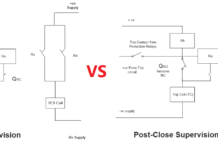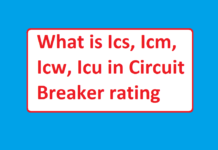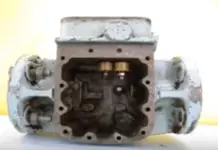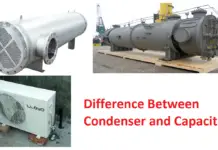Bus scheme:
The circuit for high and medium voltage switch gear installations are governed by operational consideration weather single or multiple bus bars are necessary will depend on how the system is operated and on the need for sectionizing. The choice of bus scheme is necessary for the purpose, reliability, voltage level, simplicity for relay configuration and flexible of operation, less cost, easy to maintain, large ground area, location of connecting lines, less cost, simple repair and maintenance and feature expansion and rearrangement the connection.
Single Bus scheme:
Single Bus scheme has only one bus bar section. The incoming to the bus section can be taken from the generator (if it is a source) or overhead line or underground line. i.e. if we have multiple incoming then it should be synchronized in the same busbar. The various type of load can be connected with the help of transformers or distribution lines.
Single bus scheme is used up to 33kV. It has simple a design. Mostly these systems used in rural power distributions. In rural distribution systems will be small and they have few incoming and outgoing feeders.
Pro:
- Suitable for smaller applications, a bus section allows the station to be split into two separate parts and the parts to be disconnected for maintenance.
- Low cost
- Feature expansion.
Cons:
- Serious outage occurs, in the event of failure.
- Power discontinuity, during maintenance.
- Busbar cannot be extended
- It can be used only where loads can be interrupted.
[wp_ad_camp_2]
Single bus bar with bus isolators:
To avoid the disadvantage of single bus, scheme the disconnected switches used. The bus bar is normally divided in to two parts with the help of dis connecter switches or circuit breaker or isolators. The incoming and outgoing circuits are distributed evenly in the sections. When the double feed is provided into single load, it is preferred to have one circuit from each section where each section behaves as a separate bus bar.
Advantages:
- One additional isolator or CB will be connected, which provide additional protections.
- Simple to operate
- No chance of power failure.
Disadvantage:
- If any failure occurs at one section, we will disconnect it and clear the fault.
- For Future extention and additional cost is needed for CB and isolators.
[wp_ad_camp_5]
Double Bus with Double breaker scheme:
In this bus scheme, The Load is connected through two number of bus which are main bus and standby bus. Here the second bus is used as standby bus. The standby bus will be taken into line when the main source is failed to supply power to the load circuits. We can take the power from the two source at the same time.
Advantage:
- Continues power can be delivered to the load circuits
- Easy maintenance
- Reliable bus system
- Each circuit have its own dedicated protecting system. i.e. separate circuit breakers, separate protecting relays, measuring equipments etc.
Disadvantage:
- Costlier
[wp_ad_camp_4]
Double bus with single breaker system:
It is consisting of two different bus use to deliver the load through single circuit breaker. The two bus are connected with the individual isolator and both connected through the circuit breaker. Pl see the diagram. There two isolators are connected in individual bus system. The tie breaker will be connected to perform joint operation.
Advantages:
- Continuous power supply
- Flexibility
- Possibility of separation of station sections by the use of tie breaker and isolators.
Disadvantages:
- One circuit needs four isolators and one circuit breakers
- Needs extra tie breaker.
- If fault on the tie breaker causes tripping of entire substation.
Main and Transfer Bus system:
Main Bus is always distributing the power to the load circuit. When the loads exceed the bus bar capacity, then some of the load will be transferred to the transfer bus. The transfer bus work as stand by for the main bus. Such bus scheme is used in distribution substations. The additional tie circuit breaker will be installed in between the main and transfer bus.
Advantage:
- Simple
- Less number of circuit breaker
- Less cost as compared with other bus scheme
- Any circuit breaker can be taken in to maintenance without interruption the loads.
- Does not require to install additional protection for transfer bus. The CT and PT can be installed at main bus for protecting relay.
Disadvantage:
- Switching is complicated
- Failure of any circuit breaker or bus causes tripping of entire load circuit. To avoid this, extra tie breaker to be installed in between the main bus and transfer bus.
[wp_ad_camp_4]
Ring Bus or mesh Bus scheme:
In this bus scheme, the bus bar arranged in closed loop manner. i.e. just like square shape. We can connect more than one sources to the busbar. It is an updated version of single bus scheme. All the bus bars are interconnected with the suitable circuit breaker.
Advantages:
- Single breaker is enough per branch
- Low initial cost
- Continuous power supply can be done to the load circuits.
- Breaker is involved in switching operation, therefore safe to operate
- It does not use main bus.
Disadvantage:
- Complicated connection, wrongly charging the circuit breaker causes heavy flashover, hence it requires synchronous devices when we use multiple sources.
- Relay configuration will be very complex.
- Poor relay co-ordination.
[wp_ad_camp_4]
Breaker and half with two main Bus:
This is one of the high reliable bus scheme. In this, three number of circuit breaker will be connected in series with the main bus1 and bus 2. The middle circuit breaker is considered as tie breaker. Under normal operation conductions, all the breaker is closed and both main buses are charged. During the fault condition the respective circuit breaker should isolate the faulty circuit.
Advantage:
- Reliable
- Flexible to operate
- Continues power supply
- Any breaker can be taken for service without disturbing load circuits.
The only one disadvantage of the system is, designing protection system is complicated and require additional backup protection. All the circuit breaker’s protection should be coordinated with tie circuit breaker I order to avoid tripping of main bus circuit breaker.
[wp_ad_camp_4]
Double bus bar with Bypass isolators:
Double busbar with bypass isolators are same as the main and transfer bus scheme. The only one difference is the load circuit can be connected through the isolators as shown in the diagram. Here the transfer bus also considered as main bus.
Advantages:
- Simple and economical
- Any circuit breaker can be taken for maintenance without interrupting load circuits
Disadvantage:
- The circuit provide less protection









